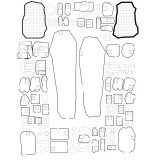What is “luggage”? How do we inhabit space?
The space contains and is contained in a multitude of storage cases, while one of the basic processes of inhabiting the space, seems to be storage. The luggage is another case connected to traveling and transport of items. It morphologically contains an empty space inside an opening case. It differs from other forms of cases in the sense that it is designed to be carried, usually on the body.
The way the space is structured, and especially the way we perceive it, is reminiscent of the morphology of luggage. As a structure we can generally analyze it as an ever-changing interior, which is contained successively in wider sets of "cases" of space, where the perception of each subject’s notion of “space” remains unique. This is due to the different luggage carried by each subject, which are usually structured starting from the familiar space of home. In other words, luggage becomes a way of perceiving space and a tool of habitation, not longer determined by the known, literal size of the object.
But what happens when we are called to inhabit new places during a journey’s beginning?
The journey is a subject’s passing through different and new places outside the familiar, which he is temporarily or permanently called to inhabit.
Our "structured" luggage follows us on the trip. They are the ones that sustain all the information that builds our subjective sense and perception of space, they also contain our well-known information storage practices. Once we are placed in the various, different and new spaces, we begin to observe the common features with our stored objects of experience, so we open our luggage in the new spaces and go through a series of comparisons. Being aware of the condition that through exposing, the interior of our different luggages can change, the way we perceive space is also subject to change. In that sense, luggage as active pieces of space and tools for its subjective perception, make us rethink the ways we travel through it.
In the end, three different baggage forms are created for a further understanding of the theoretical analysis: the luggage of words, the luggage of sound and the luggage of cities.
